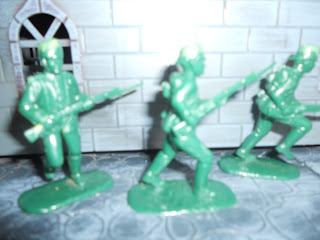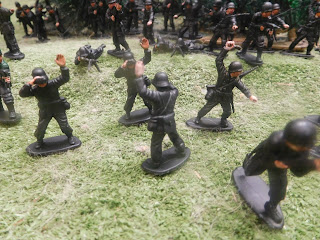Vikings Versus Toltecs - Next Wargame
The story of Cortez in Mexico always fascinated me, especially the story that he was mistaken for the god Quetzalcoatl. In more recent times a number of Latin American historians have discounted this and said it was made up later either by the Spanish or by defeated Aztecs trying to explain their defeat. However, Cortez's arrival did coincide with the designated time that the god Quetzalcoatl was expected to return.
A couple of years ago I saw a visiting display of Aztec artefacts that had come to Melbourne Museum. Morbid, but exotically beautiful, is how I would describe them with their obvious fascination with death, sacrifice and death. I spent some time sketching these and became totally absorbed.
But who was Quetzalcoatl? He is variously represented as a winged serpent and a hummingbird or a man. One of those versions has him as a bearded white man. The legends around him are intersting and he has god-like powers. Occasionally it is said he was hostile to human sacrifice, something completely out of keeping with the demands of the other gods. (The Aztecs are said to have sacrificed thousands each year, probably around 40,000 people). The memory (if that is what it is) of a bearded white man/god bringing wisdom is found also among the Inca of Peru and Polynesians.
There is not enough solid evidence to point to a historical origin but various explanations have been given including, aliens, Jesus' Second Coming (popular with some Mormons), a messenger from Atlantis (problematical because no-one knows if Atlantis was based on anything real), Middle Eastern ancients, ancient Greeks or even Vikings. Incidentally, a lot of architectural similarities exist between the Americas ancient Sumeria and Mycenae in Greece.
One of my favourite series of novels is the Casca series by Barry Sadler. A Roman soldier assigned to guarding Jesus crucifixion puts Jesus out of his misery with a spear thrust, For going to this trouble Casca is 'cursed' with immortality to be forever a soldier. In Book 2 he finds and joins up with some proto-Vikings and becomes their ruler. Eventually, after the death of his wife he designs two ocean going ship and leads an expedition into the unknown to the West, lands in the Americas and follows the coast down to Mexico where he is kidnapped for sacrifice by the 'Teotecs'.
The Teotecs ( probably a term invented by Sadler) predate the Aztecs and the Toltecs. This then fits in with the timeline as the Roman empire still exists. A number of civilisations in the region had the same gods and passed them on to successors. Casca goes on to survive sacrifice and to lead the Teotecs against the evil Olmecs. (The timeline might be wrong there because I got the impression the latter were gone by then).
But what a cool idea is it to have Vikings in Mexico? The actual Viking period of seafaring raiding came later than the Roman Empire and ended before the Aztecs. The Toltecs, who preceded the Aztecs, partially coincided with the later Viking era.
There is some serious suggestion that Vikings visited not only the Northern part of North America but might have gone further South, There is no hard evidence but just some snippets of stories that might coincide.
Some of the later Vikings also had come to trade in Thor's hammer for the cross.
Anyhow this is providing a scenario for the next wargame. The Toltecs (basically Aztec and assorted Red Indian figures, with a few Toy
way Egyptians thrown in) will outnumber the Vikings. The rules for their missile weapons will limit there damage (at least that is the plan) as they were not metal tipped and the Vikings have some metal armour and nifty shields. The Vikings will be very strong in close combat. There will be similarities to the conquistadors. The Vikings have mailed shirts as against Spaniards plate but neither were that keen on too much armour due to the festering heat. The Vikings, unlike the later Spaniards, would be unlikely to bring horses all that way and won't have fire arms although they will have some bows.
I will have a scenario similar to Cortes. Random courses of action will be: Will the Toltecs attack early? Will they welcome the strange 'giants' into the city? Will they think the Vikings or their leader is a god? How long before they outstay their welcome? How much treasure will the Vikings take with them?
The Viking leader is going to be very tough, with three or four attacks and wounds. The Toltec 'knights', Jaguar and Eagle will be tougher than other native forces but still at a disadvantage without metal weapons and trying to take Vikings for sacrifice rather than killing them.
Later I can leave the same set up and play this with Spaniards although I don't have a lot of conquistadors I'll use knights and English Civil War figures.
Last times I used Aztecs were as part of the Patran army against Fezians and also for Aztecia as it fought Fezian invaders
A couple of years ago I saw a visiting display of Aztec artefacts that had come to Melbourne Museum. Morbid, but exotically beautiful, is how I would describe them with their obvious fascination with death, sacrifice and death. I spent some time sketching these and became totally absorbed.
But who was Quetzalcoatl? He is variously represented as a winged serpent and a hummingbird or a man. One of those versions has him as a bearded white man. The legends around him are intersting and he has god-like powers. Occasionally it is said he was hostile to human sacrifice, something completely out of keeping with the demands of the other gods. (The Aztecs are said to have sacrificed thousands each year, probably around 40,000 people). The memory (if that is what it is) of a bearded white man/god bringing wisdom is found also among the Inca of Peru and Polynesians.
There is not enough solid evidence to point to a historical origin but various explanations have been given including, aliens, Jesus' Second Coming (popular with some Mormons), a messenger from Atlantis (problematical because no-one knows if Atlantis was based on anything real), Middle Eastern ancients, ancient Greeks or even Vikings. Incidentally, a lot of architectural similarities exist between the Americas ancient Sumeria and Mycenae in Greece.
One of my favourite series of novels is the Casca series by Barry Sadler. A Roman soldier assigned to guarding Jesus crucifixion puts Jesus out of his misery with a spear thrust, For going to this trouble Casca is 'cursed' with immortality to be forever a soldier. In Book 2 he finds and joins up with some proto-Vikings and becomes their ruler. Eventually, after the death of his wife he designs two ocean going ship and leads an expedition into the unknown to the West, lands in the Americas and follows the coast down to Mexico where he is kidnapped for sacrifice by the 'Teotecs'.
The Teotecs ( probably a term invented by Sadler) predate the Aztecs and the Toltecs. This then fits in with the timeline as the Roman empire still exists. A number of civilisations in the region had the same gods and passed them on to successors. Casca goes on to survive sacrifice and to lead the Teotecs against the evil Olmecs. (The timeline might be wrong there because I got the impression the latter were gone by then).
But what a cool idea is it to have Vikings in Mexico? The actual Viking period of seafaring raiding came later than the Roman Empire and ended before the Aztecs. The Toltecs, who preceded the Aztecs, partially coincided with the later Viking era.
There is some serious suggestion that Vikings visited not only the Northern part of North America but might have gone further South, There is no hard evidence but just some snippets of stories that might coincide.
Some of the later Vikings also had come to trade in Thor's hammer for the cross.
Anyhow this is providing a scenario for the next wargame. The Toltecs (basically Aztec and assorted Red Indian figures, with a few Toy
way Egyptians thrown in) will outnumber the Vikings. The rules for their missile weapons will limit there damage (at least that is the plan) as they were not metal tipped and the Vikings have some metal armour and nifty shields. The Vikings will be very strong in close combat. There will be similarities to the conquistadors. The Vikings have mailed shirts as against Spaniards plate but neither were that keen on too much armour due to the festering heat. The Vikings, unlike the later Spaniards, would be unlikely to bring horses all that way and won't have fire arms although they will have some bows.
I will have a scenario similar to Cortes. Random courses of action will be: Will the Toltecs attack early? Will they welcome the strange 'giants' into the city? Will they think the Vikings or their leader is a god? How long before they outstay their welcome? How much treasure will the Vikings take with them?
The Viking leader is going to be very tough, with three or four attacks and wounds. The Toltec 'knights', Jaguar and Eagle will be tougher than other native forces but still at a disadvantage without metal weapons and trying to take Vikings for sacrifice rather than killing them.
Later I can leave the same set up and play this with Spaniards although I don't have a lot of conquistadors I'll use knights and English Civil War figures.
Last times I used Aztecs were as part of the Patran army against Fezians and also for Aztecia as it fought Fezian invaders













Comments
Post a Comment